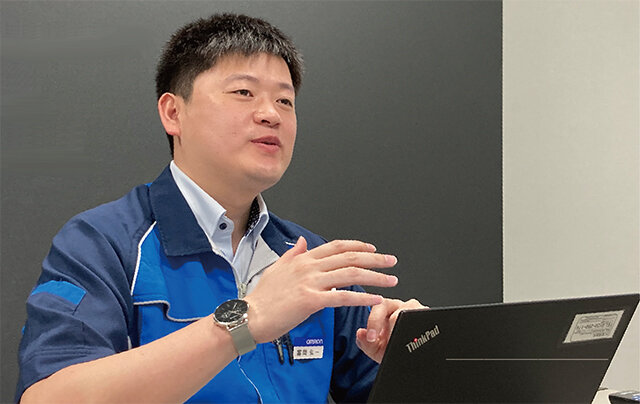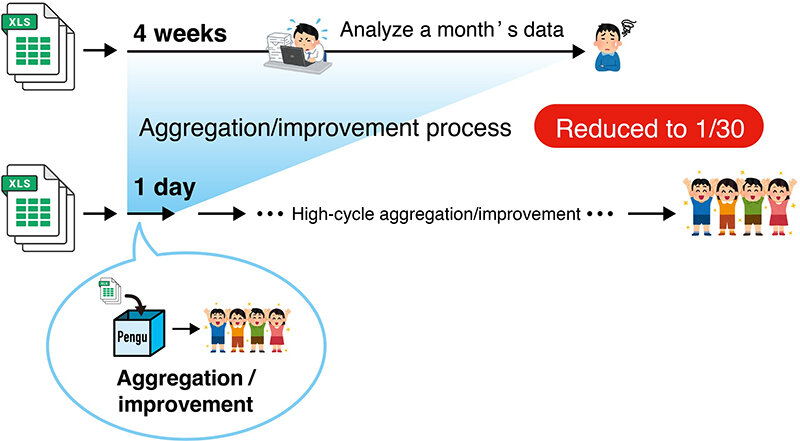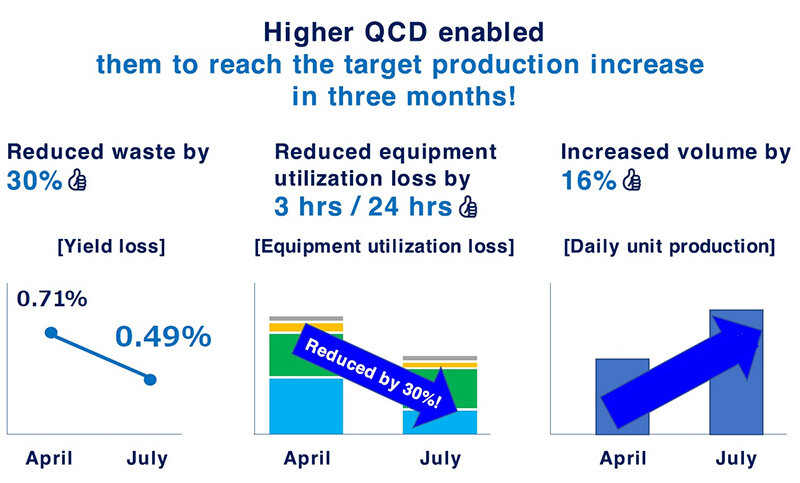
In its long-term vision, "SF2030," which kicked off in 2022, OMRON aims to realize an Autonomous Society by creating innovation driven by social needs through automation to empower people.
In a global employee vote taken to determine non-financial targets at the launch of SF2030, a training program on digital transformation (referred to as DX) was selected as the top priority target. In order to align shared recognitions throughout the Group and achieve the same targets, OMRON has defined a unique set of three elements of DX*, involving a push by all employees to promote DX.
* Customers and society: Meeting customer needs and solving social issues
ŃĆĆCompany: Innovating own operations and products/services
ŃĆĆDigital technology: Utilizing data and digital technology
ŃĆĆ
Featured in this story is how OMRON RELAY & DEVICES Corporation (OER) Kumamoto Factory successfully tackled the social issue of unmet market needs and unstable product supply by introducing business operation automation tools to promote DX on the production floor.
ŃĆĆ
In recent years, a series of profound changes in the state of the world and the global economy, including the COVID-19 pandemic and the situation in Ukraine, to name but a few, have triggered a rapid surge in semiconductor demand, coupled with serious material shortages and further demand expansion. As a consequence, production factories around the world find it hard to keep up with demand. OER Kumamoto Factory was no exception to this. Playing the central role in increasing productivity and facilitating DX, Team Leader Tomioka was keenly aware of this challenge, diligently striving to increase productivity in a bid to supply their products to customers as quickly as possible amid the growing demand.
At the time, they used paper to keep a log of errors that occurred on a daily basis, such as disposal loss and machine stoppage, a.k.a. choko-tei (short time breakdown). Then, each employee manually input the recorded numerical values into Microsoft Excel to digitalize and aggregate the data by hand, which took over an hour or so. As a result, they totaled the data in one shot once a week, which took them longer to "investigate causes" of various types of loss that occurred here and there. Worse, this increased loss levels, forming a bottleneck in the drive to increase utilization rates.
In an attempt to eliminate this bottleneck, they decided to introduce the on-site data utilization support service "pengu," which anyone can use with ease without the need for programming or other information technology skills. Their goal was to increase utilization by expediting on-site DX.
pengu is...
Business operations improvement service combining the following three business operation automation tools and training programs:
- SUISUI OCR (converting image data in PDFs to text data)
- SUISUI ETL (processing/outputting data from one system after converting it to be compatible with another system)
- SUISUI RPA (automating operations that humans do on a computer on a daily basis in the same way humans execute them)
ŃĆĆ
"Is there any automation solution that members in the field can implement themselves?" After much thought, Tomioka came up with pengu's RPA and ETL tools. To aggregate data, they use the RPA tool to extract Comma Separated Value (CSV) data from among data entered by operators. Then, using the ETL tool, they combine multiple sets of CSV data to automate data aggregation. This way, they can introduce solutions to existing facilities without having to make new modifications to machinery. They chose these tools because they can be installed without suspending factory operations, don't require huge additional investment costs, and can be customized to suit the relevant environment.

Tomioka: "There was one concern I had when introducing these new tools: 'How can I make it easy for my peers who have grown accustomed to the way they work to adapt to the new digital tools?' To break the impasse, it was probably obvious to anyone that we must give this DX-driven, new initiative a go. Yet, not a few of them were reluctant to embrace a change from the long familiar, and the last thing I wanted to do was to force them to change."
With this in mind, Tomioka began by having field operators and maintenance engineers trial the ETL tool first, assuming that he could avoid "digital allergy" and introduce it smoothly if they could see the advantages of its introduction and numerical data. Sure enough, all his team members felt the merits, and a sense of anticipation began to prevail naturally in the factory.

With the pengu RPA and ETL tools thus introduced, his mission of automating data aggregation was complete. Now, every piece of information is automatically updated as needed, rather than being manually aggregated by each operator once every week, and the data thus aggregated is made available for browsing and sharing by morning assemblies, with the result that they can discuss challenges and share areas for improvement on the spot. It was plain for everyone to see utilization rates were improving with each passing day, and daily changes were addressed without delay.
The business operation automation tools also gave birth to new movements. Some made a "to-do list" based on the issues made known to them anew and shared the list, and others proposed a solution using a macro in Microsoft Excel. They took the liberty of customizing the tools to make them more user-friendly and put the tools to more effective use. Such proactive attempts were seen everywhere.
ŃĆĆ
These initiatives worked, leading to major achievements in a short period. After the introduction of the tools, they were able to slash the time for the burdensome task of aggregating data by about 240 hours per year and increase the utilization rate by 40%. Having reduced the members' workload while also improving productivity, their attempts won high customer acclaim.

These numbers clearly show that the introduction of pengu at the Kumamoto Factory was a resounding success. Tomioka attributes this quick success to increased communication among employees from different departments.
Tomioka: "First of all, we find that automated machine operators and maintenance engineers who manage losses and take care of the machines communicate with each other more frequently than before. In the past, we relied on seasoned maintenance engineers' intuition and knacks to investigate the causes of losses and other deficiencies. After introducing the tools, I often see them work together to find solutions to common issues as they examine numerical data thus aggregated automatically to locate and share troublesome areas and causes of trouble."
Furthermore, as in the aforementioned case of utilizing Microsoft Excel macros, members began aggressively making proposals on how they could get the most out of pengu within a team, which ended up making everyone in the team more independent, improvement-minded, and digitally literate. Such ripple effects were observed everywhere, which, as Tomioka put it, was more than he had originally anticipated.
ŃĆĆ
This inspiring initiative at the OER Kumamoto Factory has been publicized throughout the OMRON Group as a benchmark of successful DX promotion, prompting planning and procurement teams to pursue similar initiatives. With other departments and offices following suit, their activities have spread organization-wide. At the Kumamoto DX Award 2022, organized by the Kumamoto Chamber of Commerce & Industry, they received the Industrial Vitalization Committee's Award from the Kumamoto Prefecture Chamber of Commerce & Industry for "training digital-technology-capable human resources and fostering business by implementing the three steps of DX," enjoying high recognition both within and outside of the Group.
Tomioka: "Knowing that they have made such a great achievement with a small investment gave them self-confidence, which has completely altered the workplace atmosphere and employees' mindset. I believe that is the single biggest benefit of introducing the tools. In fact, I can see momentum already growing for another round of reform."
Coming up from the Kumamoto Factory are the phased introduction of new equipment that automates data entry work itself and further DX through multifaceted collaboration with the Takeo Factory, Saga, and global Device & Module Solutions Business (DMB) sites. Going forward, it is expected that sales, human resources, accounting, and other departments, as well as production departments, will work to enhance productivity by automating routine tasks to increase their efficiency.
* The business operations improvement service OER introduced for this project is called "pengu," an on-site data utilization support service developed and offered by OMRON. It automatically converts handwritten information (daily reports, etc.) into text data in a format for shared use within the company, uploads the data thus converted to the system, and sends the data via email.
More Details https://lp.sdtm.omron.com (in Japanese only)